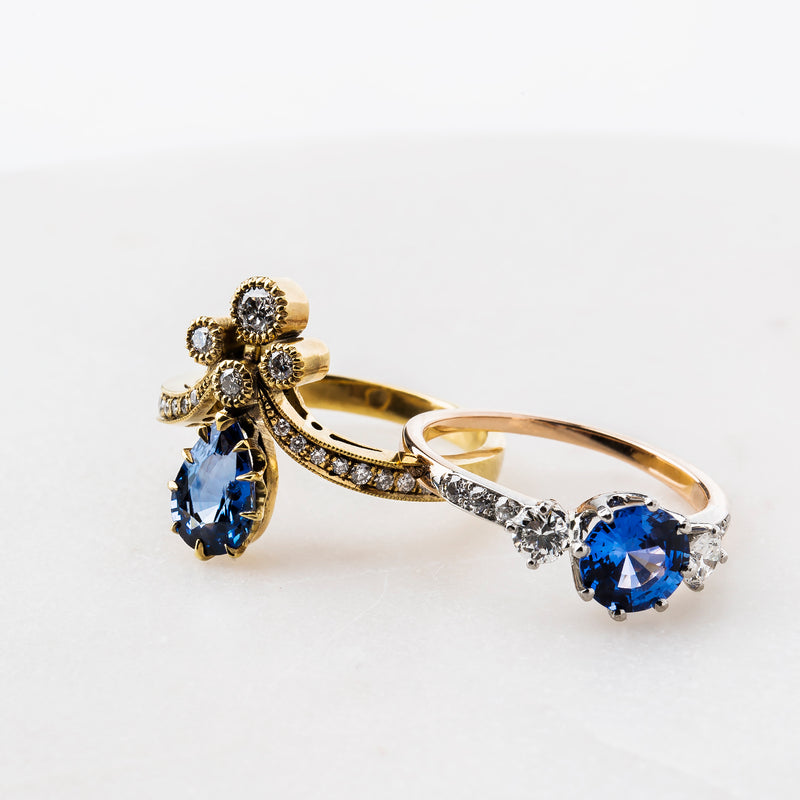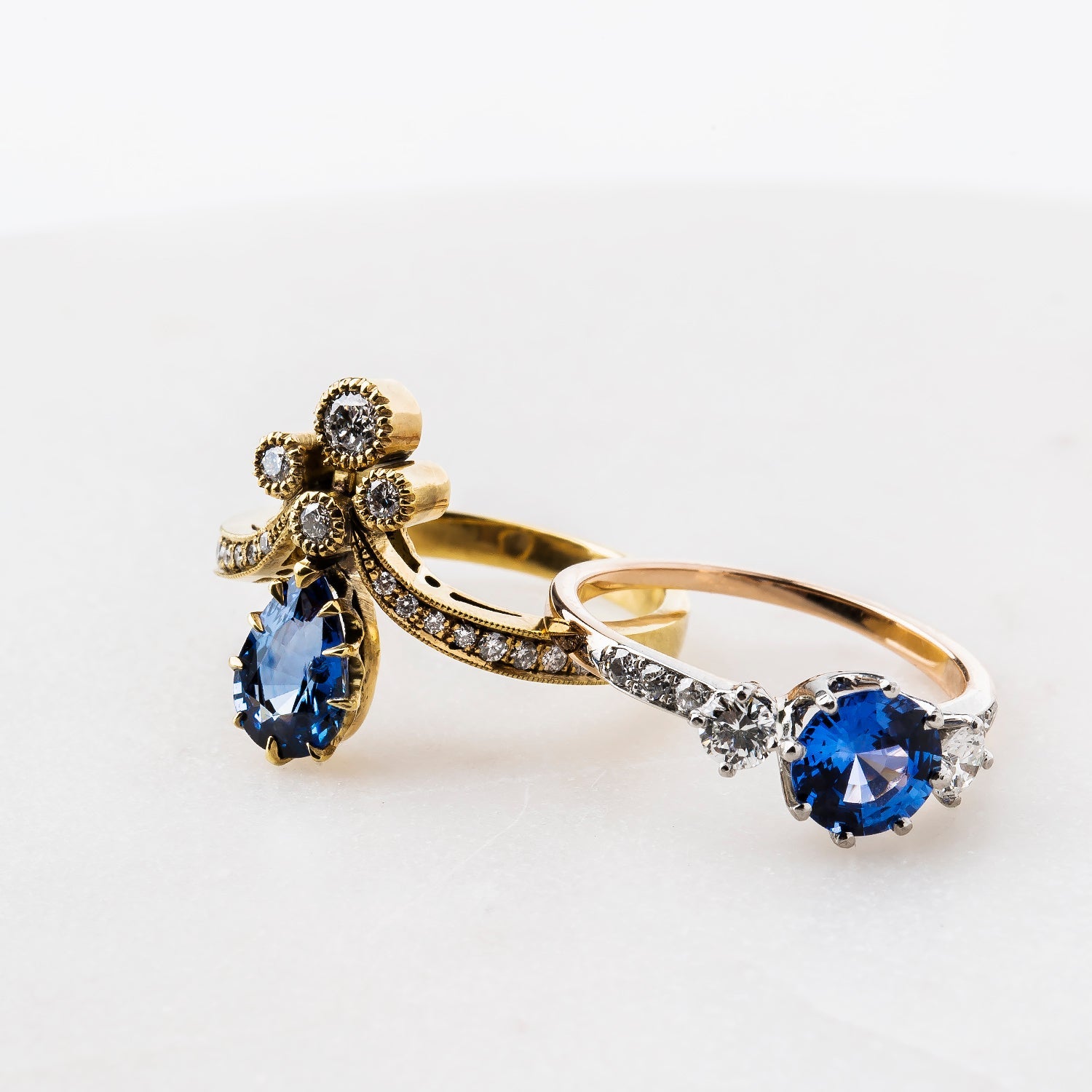
While diamonds are typically considered the most "classic" choice for an engagement ring, by no means are they the only option! The range of colored gemstones used in vintage jewelry is as colorful as the rainbow, and there are colors out there to suit every woman's personality and style. If you already know a vintage engagement ring is right for you, it's also worth noting that diamonds weren't always the most popular stone used in an engagement ring! In the Victorian era (mid to late 1800's), engagements were often celebrated with rings using birthstones instead of diamonds. In fact, diamond engagement rings didn't become popular until the 1930's. However, by the mid 1960's, about 80% of all engaged women sported a diamond engagement ring instead of a colored gemstone. Today, we all know the phrase "diamonds are a girl's best friend"… but they weren't always!
Learn About Colored Gemstones
At Trumpet & Horn, our carefully curated collection of colored gemstone engagement rings includes stones of just about every color, including sapphires, rubies, opals, emeralds, amethyst, aquamarine, and many more. For the non-traditional bride-to-be, we have a wide selection of colored engagement rings to choose from, no matter which color is your favorite! If you're considering a sapphire, ruby, or emerald engagement ring, read more about our most popular colored gemstones below. Some of the details about these colored gemstones may surprise you!
Sapphires
Sapphires are a member of the “corundum” family and refer to all colors of corundum except red. When corundum is red, we call it a ruby (see below). Sapphires are typically thought of as blue, but they can actually be almost any color including pink, yellow, and green. Fine blue sapphires are the most valuable and are highly desirable, but sapphire engagement rings can also be very affordable with a stone that is beautiful, but not considered rare. Sapphires are very hard and durable, making them a great stone to use for jewelry. Most sapphires are heat treated to enhance their color - about 90% or more of all sapphires are heat treated. This treatment is stable, permanent, and when disclosed to the buyer, perfectly acceptable for all sapphire engagement rings.
Rubies
Rubies are also a member of the “corundum” family and refer to all stones of this family that are red. The most desirable shade of ruby is called “pigeon’s blood”, which is pure red with just a hint of blue. An exceptional ruby that is very large is rare, and will often times be more expensive than a diamond. Like sapphires, rubies are very hard and durable, making them an excellent choice to wear in jewelry, and many vintage ruby rings can be fairly inexpensive compared to their diamond counterparts. It is also common for rubies to be heat treated to enhance their color. This treatment is stable, permanent, and when disclosed to the buyer, perfectly acceptable.
Emeralds
Emeralds are the most precious stone in the “beryl” family. The green color of emeralds is due to the presence of chrome in its chemical structure. Highly transparent, rich green emeralds are extremely rare and expensive. Emeralds are typically highly included (internally flawed) and only the very finest examples are transparent. Inclusions are not seen as faults in emeralds since the majority of stones are clouded this way. It is very common for most emeralds to be oiled in some way to hide fractures, and when disclosed to the buyer it is perfectly acceptable. However, oiling treatments are not very stable and care should be taken to keep the stones away from heat and ultrasonic jewelry cleaners. Emeralds are also a fairly soft stone, and they are much more highly prone to scratches and breakage than diamonds, sapphires, and rubies. While you do need to be a bit more careful when wearing an emerald, if your vintage emerald engagement ring is cared for and worn properly, it will last several lifetimes.
Opal
Opal is different from most of the colored gemstones in the T&H Collection as it is not "technically" considered a mineral because it is primarily made up of anywhere between 3% and 30% water. Opals are extremely fragile because of this water content and those with higher water content also have a higher chance of breaking, meaning that a little extra care must be taken if you choose to wear a vintage opal ring! Most opals have what’s called "play of color", referring to the rainbow of colors that flash when an opal catches the light. This play of color occurs because of the way the silica spheres are stacked in an orderly fashion on top of each other. 97% of the world's opal supply comes from Australia, but they are also found in the United States, South America and Eastern Europe, among other places.
Tourmalines
Tourmalines are typically seen in green and pink. However, many people don’t realize that tourmaline can come in almost any color you can imagine, and one gemstone can have more than one color as well! For example, "watermelon" tourmaline occurs when a ring of green tourmaline forms around a center core of pink tourmaline like a slice of watermelon. Tourmalines are mined mainly in Brazil, Africa and the United States. One of the main deposits in the U.S. is the Himalaya Mine in San Diego county known for its bright pink tourmalines. An interesting property of tourmaline is that it can become electrically charged when heated and then cooled and by applying pressure such as rubbing it on a surface. The stone will then attract dust and other particles. This effect is called pyro-electricity and because of this, tourmalines should be cleaned more often than other gemstones. Heating tourmaline can sometimes change or enhance the color of the stone, but this treatment is not always permanent.
Jade
Jade is most often thought of as a green mineral but can occur in a wide variety of colors including brown and lavender. Its value lies in its beauty and is judged by its color, texture, translucency and size. If there are multiple pieces of jade in an item of jewelry then how well the jade is matched is also part of determining value. Imperial jade is the most coveted type of jade and is a rich emerald green color that is translucent to almost transparent. It is important to note that a majority of jade available today has undergone some form of treatment such as dying or heating to improve its color.
Amethyst
Amethyst is the most highly valued gemstone in the quartz family. It ranges in color from a light lavender called “Rose de France” to a deep rich purple. It can also have a tinge of blue or red to its overall color as well. The word amethyst comes from ancient Greek and means “not drunken” since it is thought that wearing amethyst will protect the wearer from drunkenness. Amethyst has been used in jewelry throughout the centuries by the Egyptians, Greeks and medieval Europeans to name a few. It has also been a favorite gemstone of the Christian church and many amethysts have been used in religious jewelry. The most notable locations for amethyst are in Brazil, Madagascar, Russia and the United States. The Four Peaks mine in Arizona has produced highly desirable deep royal purple amethyst with a hint of red. Heating amethyst can change its color to green. These green quartz stones are called Prasiolite.
Citrine
Citrine is a yellow or golden variety of the quartz family. Naturally colored citrine is a very light yellow and are very rare. Most citrine is actually light colored amethyst or smoky quartz that has been heated to bring out a rich yellow color. This heat treatment is completely stable and accepted in the jewelry industry. Natural color citrine is mined in many different countries including Brazil, Madagascar and the United States.
Turquoise
Turquoise means “Turkish Stone” because it entered Europe via a trade route through Turkey. It is an opaque stone that is bluish-green and commonly includes spots or veins of the host rock material called "matrix." Turquoise that does not contain any matrix is highly prized and can be extremely valuable. Turquoise is relatively soft and can scratch easily. It’s also porous and can be discolored by oils from skin or lotions. Because it is porous, it is often treated with fillers like wax or resin to fill fissures and to stabilize the color. Turquoise is one of the oldest documented minerals to date. Ancient Egyptians, the Aztecs, Persian and Mesopotamian societies, and even ancient China all mined and used turquoise for adornment. There are many mines for turquoise in the United States, with Arizona being the most important producer. The most famous mine in Arizona is the Sleeping Beauty mine in Globe, AZ. However, the finest and most highly prized turquoise is Persian turquoise with an intense blue “robins egg” color that is free of any matrix.
Aquamarine
Aquamarines are semi-precious stones, unlike most of the jewelry you see in our collection. The name "Aquamarine" was derived from an old Latin expression meaning "seawater", and rightly so, since these beautiful blue-green stones have an amazing glass-like luster to them. While they are most famous for the breathtaking medium sea blue color we've come to know (and love!) as "aquamarine", the gemstone can range in color anywhere from very light to dark blue with various levels of green. Aquamarines are exactly the same as emeralds in terms of crystal structure, but the only difference is the chemical composition that makes aquamarines blue, and emeralds green! These beautiful colored stones were typically used in war times (especially in the 1940's) because they were less expensive, and bigger stones actually exist without being outrageously expensive compared to their precious gemstone counterparts. While most aquamarines are mined in Brazil, they can be found all over the world in various countries like Mozambique, Kenya, Sri Lanka, Pakistan, Afghanistan, and Russia.





























